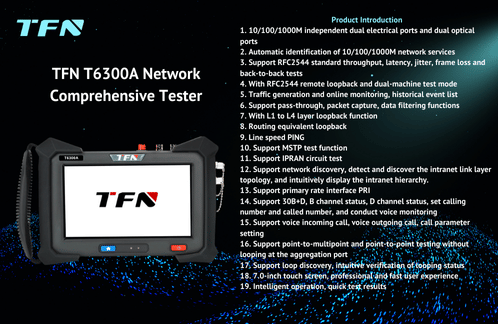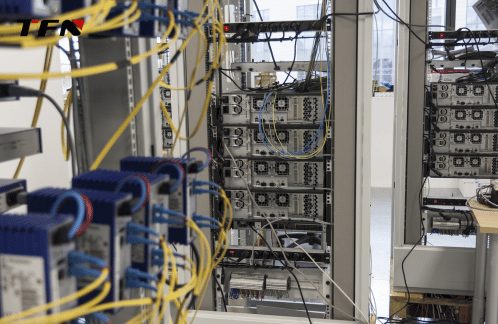Functions and Applications of TFN T6300A Network Comprehensive Tester
Network comprehensive tester is a key tool for network maintenance. It can detect network functions at all levels in detail, quickly locate and troubleshoot faults, significantly improve the work efficiency of network administrators, and ensure the stable operation of the network. Whether it is new network deployment or old network maintenance, network comprehensive tester is indispensable.
TFN T6300A Network Comprehensive Tester (abbreviated as "T6300A") is a network comprehensive tester that integrates multiple physical interfaces such as 10/100/1000M Ethernet, E1, PRI, V.35/V.24, OTDR, optical power meter test, etc. It has multi-functional integration, high-precision testing, and intelligent operation interface. It is widely used in troubleshooting and performance monitoring of various network environments, providing users with convenient and effective testing solutions.

Its main functions include:
1.10/100/1000M Ethernet test: It can test the performance of 10M, 100M, and 1000M Ethernet interfaces, including throughput, latency, jitter, frame loss, etc., to ensure network stability. This test function mainly includes the following aspects:
10/100/1000M independent dual electrical ports and dual optical ports: Support Ethernet interfaces of different rates, suitable for various network environments.
Automatically identify 10/100/1000M network services: No manual configuration is required, automatically adapt to different network speeds, and simplify the test process.
Support RFC2544 standard throughput, latency, jitter, frame loss and back-to-back tests: Evaluate the performance of network equipment and ensure network stability and quality.
With RFC2544 remote loopback and dual-machine test mode: Support remote testing, simulate real network environment, and improve test efficiency.
Traffic generation and online monitoring, historical event list: simulate actual network traffic, monitor network status in real time, and record historical data for analysis.
Support penetration, packet capture, and data filtering functions: simulate real network environment, capture data packets for in-depth analysis, and filter specific data.
With L1 to L4 layer loopback function: perform loopback tests at different layers of the network to locate and solve network problems.
Route equivalent loopback: simulate router behavior, test routing performance, and ensure correct routing configuration.
Line speed PING: quickly detect network connectivity and stability, and discover network faults in time.
Support MSTP test function: simulate actual network traffic, test network performance and capacity.
Support IPRAN circuit test: evaluate IPRAN circuit transmission quality and quickly locate faults.
Support network discovery, detect and discover the intranet link layer topology, and intuitively display the intranet hierarchy: help users understand the network structure and facilitate network planning and management.
Support aggregation port without looping to achieve point-to-multipoint and point-to-point testing: simplify test configuration and improve test efficiency.
Support loop detection and intuitive verification of loop status: Help users quickly detect and locate loop problems in the network.
2.PRI function test: refers to testing the performance and status of the PRI (Primary Rate Interface) interface, including the 30B+D channel, B channel and D channel status, as well as supporting voice inbound and outbound calls and other functions to ensure that the PRI line operates normally in applications such as operator voice services and router to PBX equipment voice lines. This test function mainly includes the following aspects:
Support 30B+D, B channel status, D channel status, set the calling number and called number, and conduct call monitoring: This function allows users to test the performance of the 30B+D interface, including the status of the B channel (transmitting voice, data, etc.) and the D channel (transmitting signaling). Users can also set the calling and called numbers and monitor the call process to evaluate the call quality.
Link layer supports LAPD, ITU-T Q.921 specifications: The link layer of the tester supports LAPD (Link Access Protocol D channel) and ITU-T Q.921 specifications to ensure that the communication of the data link layer meets international standards, thereby improving the accuracy and reliability of the test.
Network layer supports ITU-T Q.931 specification: The network layer supports ITU-T Q.931 specification, which defines the ISDN network layer interface protocol for establishing, maintaining and terminating logical connections between devices. The tester follows this specification and can test the connectivity and stability of the ISDN network.
Can simulate TE and NT: The tester can simulate terminal equipment (TE) and network terminal equipment (NT), thereby simulating a real ISDN network environment and performing end-to-end performance testing.
Support voice incoming and outgoing calls: The tester supports simulated voice incoming and outgoing calls, and can test the availability and quality of voice services, including call establishment, call quality and other aspects.
Support call parameter settings: Users can set call parameters such as call duration, call interval, etc. according to test requirements to meet test requirements in different scenarios.
Insertion and extraction of voice through headphones and microphones: During the test, users can insert or extract voice data in real time by connecting headphones and microphones to the tester to evaluate the real-time and quality of voice communication.

3.E1/V.35/V.24 functional test: refers to the test equipment evaluating the performance and status of these interfaces to ensure the stability and reliability of data transmission. E1 interface test can be used to evaluate the transmission performance of E1 lines, such as the transmission rate of 2.048Mbps; V.35/V.24 interface test can be used to simulate synchronous or asynchronous data transmission and detect the compatibility and performance of the interface. This test function mainly includes the following aspects:
Provide E1, v.35/v.24 interface test: Test the performance of E1, V.35, and V.24 interfaces to ensure the stability and reliability of these interfaces in data transmission.
BERT error characteristic test (G.821.G.826, M.2100/550): Use BERT technology to perform bit error rate test, follow ITU-T G.821, G.826 and other standards, evaluate the accuracy and reliability of data transmission, and help find errors in the transmission process.
Support FRAME RELAY, HDLC, PPP, Ethernet protocol testing: Test the support of network equipment for FRAME RELAY, HDLC, PPP, Ethernet and other protocols to ensure that the equipment can correctly understand and process these protocols and improve network compatibility.
Support Ping and loopback Ping tests on E1, V.35/V.24 links: Perform Ping and loopback Ping operations on E1, V.35, and V.24 links to check the connectivity of the link and help locate network faults.
Automatic detection of target IP address (HDLC/PPP/FR) function: Automatically detect the target IP address on the link using HDLC, PPP, and FRAME RELAY protocols to simplify network configuration and speed up troubleshooting.
Automatic detection of link status and automatic configuration of port parameters: The device can automatically detect the link status and automatically configure port parameters as needed to improve the automation level of network management and reduce manual intervention.
Automatic display of loop discovery: The device can automatically detect and display the loop situation in the network, helping administrators to promptly discover and solve potential network problems and ensure the stability and reliability of the network.
In addition to the above functions, the T6300A network comprehensive tester also has functions such as optical power meter/red light source test and OTDR test, providing users with detailed network testing solutions.
T6300A can be applied in many fields. Its powerful functions and wide compatibility make it an important tool for network management and maintenance. The following are its main application areas:
1. Network Engineering
2. Communication Field
3. Data Center
4. Cloud Computing
5 Network Security

In short, the TFN T6300A network comprehensive tester has diverse functions and a wide range of application scenarios. It plays an important role in network engineering, data centers, fiber optic communications, cloud computing, network security and other fields. The tester can help users quickly locate faults, optimize network configuration, and ensure stable network operation. It is an indispensable test equipment in the field of network communications.
If you are interested in the TFN T6300A network comprehensive tester, please contact the TFN sales team:
Email: info@tfngj.com
WhatsApp: +86-18765219251
Facebook: https://www.facebook.com/tfnfate/
